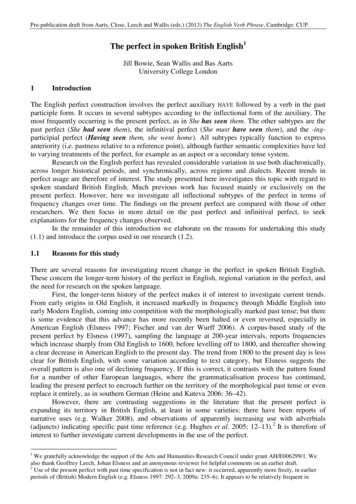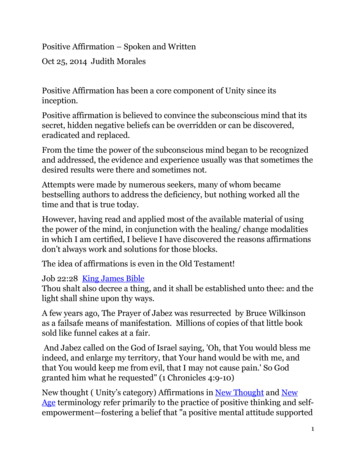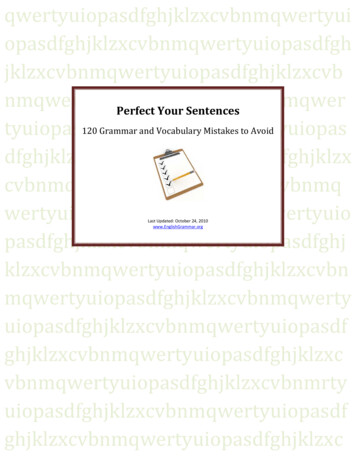
Transcription
Pre-publication draft from Aarts, Close, Leech and Wallis (eds.) (2013) The English Verb Phrase, Cambridge: CUP.The perfect in spoken British English1Jill Bowie, Sean Wallis and Bas AartsUniversity College London1IntroductionThe English perfect construction involves the perfect auxiliary HAVE followed by a verb in the pastparticiple form. It occurs in several subtypes according to the inflectional form of the auxiliary. Themost frequently occurring is the present perfect, as in She has seen them. The other subtypes are thepast perfect (She had seen them), the infinitival perfect (She must have seen them), and the -ingparticipial perfect (Having seen them, she went home). All subtypes typically function to expressanteriority (i.e. pastness relative to a reference point), although further semantic complexities have ledto varying treatments of the perfect, for example as an aspect or a secondary tense system.Research on the English perfect has revealed considerable variation in use both diachronically,across longer historical periods, and synchronically, across regions and dialects. Recent trends inperfect usage are therefore of interest. The study presented here investigates this topic with regard tospoken standard British English. Much previous work has focused mainly or exclusively on thepresent perfect. However, here we investigate all inflectional subtypes of the perfect in terms offrequency changes over time. The findings on the present perfect are compared with those of otherresearchers. We then focus in more detail on the past perfect and infinitival perfect, to seekexplanations for the frequency changes observed.In the remainder of this introduction we elaborate on the reasons for undertaking this study(1.1) and introduce the corpus used in our research (1.2).1.1Reasons for this studyThere are several reasons for investigating recent change in the perfect in spoken British English.These concern the longer-term history of the perfect in English, regional variation in the perfect, andthe need for research on the spoken language.First, the longer-term history of the perfect makes it of interest to investigate current trends.From early origins in Old English, it increased markedly in frequency through Middle English intoearly Modern English, coming into competition with the morphologically marked past tense; but thereis some evidence that this advance has more recently been halted or even reversed, especially inAmerican English (Elsness 1997; Fischer and van der Wurff 2006). A corpus-based study of thepresent perfect by Elsness (1997), sampling the language at 200-year intervals, reports frequencieswhich increase sharply from Old English to 1600, before levelling off to 1800, and thereafter showinga clear decrease in American English to the present day. The trend from 1800 to the present day is lessclear for British English, with some variation according to text category, but Elsness suggests theoverall pattern is also one of declining frequency. If this is correct, it contrasts with the pattern foundfor a number of other European languages, where the grammaticalisation process has continued,leading the present perfect to encroach further on the territory of the morphological past tense or evenreplace it entirely, as in southern German (Heine and Kuteva 2006: 36–42).However, there are contrasting suggestions in the literature that the present perfect isexpanding its territory in British English, at least in some varieties: there have been reports ofnarrative uses (e.g. Walker 2008), and observations of apparently increasing use with adverbials(adjuncts) indicating specific past time reference (e.g. Hughes et al. 2005: 12–13).2 It is therefore ofinterest to further investigate current developments in the use of the perfect.1We gratefully acknowledge the support of the Arts and Humanities Research Council under grant AH/E006299/1. Wealso thank Geoffrey Leech, Johan Elsness and an anonymous reviewer for helpful comments on an earlier draft.2Use of the present perfect with past time specification is not in fact new: it occurred, apparently more freely, in earlierperiods of (British) Modern English (e.g. Elsness 1997: 292–3, 2009a: 235–6). It appears to be relatively frequent in
Second, there is evidence of synchronic regional variation, with a number of studies showing alower frequency of the present perfect in American than in British English (e.g. Elsness 1997; Hundtand Smith 2009).3 It is therefore worth investigating whether British English usage is changing underthe influence of American English in this area as appears to be the case for some other areas ofgrammar (e.g. Leech et al. 2009). Elsness (1997), though focusing on the present perfect, also reportsdata showing regional variation in the past and infinitival perfect forms in contemporary printedEnglish, with proportions of both forms again significantly lower in American than in British English,and again having fallen in American English since 1800.4 Gorrell (1995) cites examples from recentAmerican English which suggest there may be further decline in the past perfect in this variety. Thesepoints indicate that the past and infinitival forms are also worthy of investigation in terms of currentchange.Third, there is a need for more research on spoken English. In exploring short-term change, itis particularly valuable to look at spoken language, where changes in grammar are likely to firstbecome evident. For the written language, recent change in the present perfect has been investigatedby Hundt and Smith (2009), based on the ‘Brown quartet’. These are four one-million-word corporaof printed English: for British English, LOB and FLOB (containing material from 1961 and 1991respectively), and for American English, Brown and Frown (1961 and 1992). The present study drawson data from a corpus of spoken British English which covers a similar time period, introduced in thenext section.In this study we aimed to answer the following research questions: Does the frequency of use of the perfect change significantly in spoken standard BritishEnglish from the 1960s to the 1990s? How do the subtypes of the perfect compare in this regard? What are the explanatory factors behind any frequency changes found?We also decided to compare different baselines for measuring change over time, going beyond permillion-word measures to what we will argue are more informative measures, calculated as aproportion of VPs or past-marked VPs.1.2The corpusThe data in this study is drawn from the Diachronic Corpus of Present-day Spoken English (DCPSE),a parsed corpus of mainly spontaneous British English speech (described in more detail in Aarts et al.,this volume). It comprises two subcorpora of over 400,000 words each in matching text categories,allowing diachronic comparison over a thirty-year span. The subcorpora contain material from (i) theLondon–Lund Corpus (LLC) dating from the late 1950s to the 1970s, and (ii) the British Componentof the International Corpus of English (ICE-GB) collected in the early 1990s.DCPSE is fully parsed in the form of phrase structure tree diagrams, and is searchable withdedicated corpus exploration software called ICECUP 3.1 (International Corpus of English CorpusUtility Program 3.1).5 An example of a tree diagram for a sentence from the corpus is shown inFigure 1.contemporary spoken Australian English (Engel and Ritz 2000; Elsness 2009b), for which narrative uses have also beenreported (Engel and Ritz 2000).3There has also been considerable research on the perfect in a number of other contemporary and earlier varieties ofEnglish (e.g. Tagliamonte 2000 on Samaná English, spoken by a small community in the Dominican Republic; Siemund2004 on Irish English; van Herk 2008 on early African American English). A review of this literature is beyond the scopeof this paper.4For the infinitival perfect, we performed our own calculations based on combinations of the figures provided by Elsnessfor several different constructions involving this form (pp. 104, 267–8).5See Svartvik (1990) on LLC and Nelson et al. (2002) on ICE-GB and ICECUP; for more information on DCPSE, publication draft of Aarts, Close and Wallis (2013), ‘The perfect in spoken British English’ in Aarts, Close, Leech andWallis (eds.) The English Verb Phrase, CUP. » www.cambridge.org/gb/knowledge/isbn/item6943712
Figure 1. Tree diagram for the sentence I haven’t lost it.6The tree is displayed here branching from left to right. Each node of the tree has three sections:the upper right section shows categorial information (such as ‘NP’ for noun phrase, ‘PRON’ forpronoun), the upper left section displays functional information (such as ‘SU’ for subject, ‘NPHD’ fornoun phrase head), and the lower section shows additional features (such as ‘montr’ formonotransitive, ‘pres’ for present tense).ICECUP provides the facility to search for grammatical structures by constructing Fuzzy TreeFragments or FTFs (Aarts et al. 1998; Nelson et al. 2002).7 FTFs are a kind of ‘wild card’ forgrammar: partial tree diagrams in which varying levels of detail can be specified that will then matchthe same configuration in trees. Figure 2 shows a single-node FTF designed to find every instance of apresent-tense perfect auxiliary. Figure 3 shows a more complex FTF, in the form of a mini tree, whichsearches for every VP containing an infinitival perfect auxiliary preceded by a modal auxiliary verb.Figure 2. A simple FTF to search for a present perfect auxiliary.Note that, in the phrase structure grammar used in DCPSE, a VP consists of the lexical verbtogether with any accompanying auxiliaries: that is, of a verbal group excluding such elements asobjects and adverbials which occur after the lexical verb (but including any interposed adverbials, asin It might well have been).8 Where an auxiliary is separated from the rest of the VP (e.g. in aninterrogative, where the first auxiliary precedes the subject), it is treated as a daughter of the clause.6Gloss (features are in italics): PU parsing unit; CL clause; main main; montr monotransitive; SU subject; NP noun phrase; NPHD noun phrase head; PRON pronoun; pers personal; sing singular; VB verbal; VP verbphrase; pres present (tense); OP operator; AUX auxiliary; perf perfect; MVB main verb; V verb; edp -edparticiple; OD direct object.7See also www.ucl.ac.uk/english-usage/resources/ftfs.8There are of course other analyses of the VP in the linguistic literature; here we are not concerned with competinganalyses, but with practical issues of data retrieval.Pre-publication draft of Aarts, Close and Wallis (2013), ‘The perfect in spoken British English’ in Aarts, Close, Leech andWallis (eds.) The English Verb Phrase, CUP. » www.cambridge.org/gb/knowledge/isbn/item6943712
Figure 3. FTF for an infinitival perfect auxiliary following a modal auxiliary under a VP. The white arrow requires that thesecond auxiliary follows the first, but not necessarily in strict succession.While a parsed corpus like DCPSE offers many advantages in studying grammaticalstructures, it is always important to check the results of electronic searches for accuracy andcompleteness. The design of ICECUP facilitates an exploratory mode of working with the data so thatthe user can readily confirm results by inspecting matching sentences.In the next section of the paper we present data for frequency changes in the perfectconstruction across the two subcorpora of DCPSE, comparing trends for the construction as a wholeand for the different inflectional subtypes. The trends seen for the past perfect and infinitival perfectare then taken up in more detail in section 3. Finally, we present our conclusions in section 4.2Subtypes of the perfect: frequency trendsAs mentioned above, the perfect construction occurs in present, past and non-finite forms, all of whichtypically express anteriority to a reference point. Before presenting our quantitative findings, wesurvey these subtypes of the perfect in a little more detail, providing examples from DCPSE. Ourdescription draws on accounts in the literature, including standard grammars such as Quirk et al.(1985) and Huddleston and Pullum et al. (2002).Examples of the present perfect and past perfect are given in (1) and (2) respectively:9(1)(2)I’ve done a bit of writing before [DI-A07 #176]I was staying in this sort of bedsitter place that she’d booked up for me[DL-B19 #655]The present perfect (with auxiliary HAVE in the present tense) typically expresses anteriority relativeto the present: in (1) we understand that the writing was done ‘before now’. The past perfect (with theauxiliary in the past tense) typically indicates anteriority to a past reference point: in (2), weunderstand that the ‘staying’ was in the past, and the ‘booking up’ happened before the staying.10The two non-finite subtypes of the perfect are illustrated below. The first is the infinitivalperfect: the auxiliary either occurs as a bare infinitive following a modal auxiliary, as in (3), orfollows the infinitival marker to, as in (4). The second non-finite subtype is the -ing-participial perfect,as in (5).(3)(4)(5)I must have told you that [DL-B19 #271]the virus seems to have cleared up [DI-A10 #140]Her daughter Carol having produced coffee for the waiting reporters offered somethoughts on the matter [DI-J04 #108]The non-finite subtypes also indicate anteriority, with the reference point determined by the largerlinguistic context in which they occur (Huddleston and Pullum et al. 2002: 140, 161–2). For example,9Examples from DCPSE are cited with their identifying text codes (prefixes ‘DL’ and ‘DI’ indicate LLC and ICE-GBsubcorpora respectively).10Other uses of the past perfect (in backshifting and modal remoteness contexts) are discussed in section 3.Pre-publication draft of Aarts, Close and Wallis (2013), ‘The perfect in spoken British English’ in Aarts, Close, Leech andWallis (eds.) The English Verb Phrase, CUP. » www.cambridge.org/gb/knowledge/isbn/item6943712
in (4) the ‘clearing up’ is understood as happening before the present time referred to by seems, whilein (5) the ‘producing coffee’ is understood as happening before the past time at which the ‘offering ofthoughts’ occurred.The meaning of the present perfect is, however, more complex than anteriority to a presentreference point. It contrasts with the (morphologically marked) past tense in ways which are difficultto characterise (for a detailed discussion, see Elsness 1997). Briefly, the present perfect presents asituation as occurring within (or even continuing through) a timespan beginning in the past andleading up to the present. It also typically involves a focus on the present repercussions of the situation(often labelled ‘current relevance’), and generally resists co-occurrence with expressions indicating aspecific past time reference (such as last year). In contrast, the past tense is readily used to refer to atime viewed as wholly in the past rather than connected to the present. For example, he’s lost his jobtends to highlight the current state of affairs (his joblessness) resulting from the past event, while helost his job is compatible with reference to a particular time in the past (such as last year) and couldoccur as part of a narrated sequence of past events. Where the situation continues up to the present, thepresent perfect is generally required (They’ve known him since 1983 vs *They knew him since 1983).Admittedly, the distribution of the two forms is not altogether clear-cut, and varies somewhat acrossvarieties of English, so these distinctions are sometimes blurred.11The contrast between present perfect and past tense is neutralised in the other perfect subtypes(i.e. the past perfect and non-finite perfects), which can correspond to either a present perfect or asimple past (Huddleston and Pullum et al. 2002: 146). This is illustrated by the following examples ofthe infinitival perfect, where (6) corresponds to a present perfect (with since the election specifying aperiod up to the speaker’s present) and (7) to a simple past (as a specific time in the past is underdiscussion). That is, the content of the claim in (6) would be rendered as ‘We have achieved x sincethe election’, that in (7) as ‘I heard a great deal of noise .’).(6)(7)tick off for me the main things that you would claim to have achieved as a governmentsince the election [DL-E02 #27]and Mr Perry [ ] claimed [ ] to have heard a great deal of noise from this motorcycle as it came along followed by the bang [DL-J04 #99]Having identified subtypes of the perfect, we can now attempt to explore how their usage maychange over time. Aarts et al. (this volume) discuss three different baselines for measuring frequenciesand evaluating change over time. These are: simple word frequency, frequency of a higher-ordergrammatical term (e.g. VP frequency for progressive verbs), and the frequency of members of a set ofalternants containing the item. Aarts et al. argue that, wherever possible, one should employ abaseline for comparison that is closest to the set of choices that speakers are making between forms asthis will provide the most informative results.In the remainder of this section we compare the results of several different methods as appliedto subtypes of the perfect. First, frequencies of perfect auxiliaries per million words are reported.Next, the perfect is considered as a choice (a) within the set of VPs, and (b) within the set of tensed,past-marked VPs (defined as tensed VPs marked for past either inflectionally or with the perfect, orboth).11For example, the following kinds of uses have been reported in the literature: past tense with current relevance,especially in American English (He (just) lost his job; Did you ever visit Rome?); past tense with always for a statecontinuing up to the present (I want to see what happens next— I always liked a good story for a starter, and I like to seehow they finish off [DI-D06#219–20]; cf. Elsness 1997: 132; Leech 2004: 43); present perfect with past time adverbial (oh I’vegot [ ‘navigated’] them through there ages ago [DL-B11#737]). Several studies note variation in the use of the perfect amongdifferent regional and/or non-standard varieties of British English (e.g. Sampson 2002; Miller 2004).Pre-publication draft of Aarts, Close and Wallis (2013), ‘The perfect in spoken British English’ in Aarts, Close, Leech andWallis (eds.) The English Verb Phrase, CUP. » www.cambridge.org/gb/knowledge/isbn/item6943712
2.1Perfect auxiliaries per million words2.1.1 Data retrievalInstances of the perfect auxiliary were retrieved by using a simple FTF search for a single node ofcategory ‘AUX’ with the auxiliary type feature ‘perf’. Different values of the inflectional‘tense/mood/form’ feature were added in turn to this node to carry out more specific searches forperfect auxiliaries occurring in present tense, past tense, or one of the non-finite forms. An FTF usedto search for perfect auxiliaries in the present tense form is shown in Figure 2 above.The frequent combination HAVE got required special attention: while some instances clearlybelong to the perfect construction (e.g. How advanced have they got [DI-B24 #63]), the majority do not.Instead they represent an idiom which is historically derived from a perfect construction but is nowsemantically distinct, expressing various stative meanings (Huddleston and Pullum et al. 2002: 111–13). Occurrences of this idiom as ‘semi-modal’ HAVE got [to] (as in a lot of work has got to be doneon it [DL-A04 #265]) were unproblematic: these were automatically excluded by our FTF searches, as it isanalysed in the corpus as a semi-auxiliary (an auxiliary with the type feature ‘semi’). However, oursearches did include instances of the idiom taking an NP object and expressing a stative meaning suchas possession (or a similar relationship): an example is Well he’s got two kids for one thing [DI-B63 #124](normally used to describe a present state of affairs, ‘he has two kids’, rather than to mean ‘He hasobtained two kids’).12We therefore used FTFs to find instances where HAVE, parsed as a perfect auxiliary, wasfollowed by got (allowing for intervening material such as adverbs). In our spoken data, these werevery frequent in the present tense category, contributing around 24% of examples; examination of10% random samples of occurrences (from each of the subcorpora, LLC and ICE-GB) showed that amajority of examples were stative or ambiguous, so all instances were excluded from the counts forthe present subtype of perfect.13 Occurrences with got were far less frequent in the other inflectionalcategories (i.e. past, infinitive, and -ing participle); all examples were examined, and stative andambiguous ones excluded from the counts (necessary only for the past category).2.1.2 ResultsTable 1 analyses the results using per million words (‘pmw’) as a baseline, contrasting LLC (theearlier subcorpus) and ICE-GB (the later subcorpus).14 We report percentage swing d% and the resultsof two types of goodness of fit χ2 test.Overall, the perfect auxiliary declines in frequency by about 10% across the two subcorpora(Table 1, Total row). However, when the data for the different inflectional categories are considered,it becomes clear that not every perfect subtype behaves in the same manner. Past and infinitivalsubtypes fall by around 34% and 30% respectively, whereas the present (which is by far the mostfrequent of the subtypes) is stable. The figures for the -ing participle are small, and its fall is notstatistically significant.12Such stative examples are included in some corpus counts of the perfect (e.g. Biber et al. 1999: 463–7, who report GETas the most frequently occurring verb in this construction in British English conversation).13This does exclude some genuine perfect examples. The results of Table 1 were checked against an alternative calculationwhich excluded only stative and ambiguous examples involving got for the present tense category, based on estimationsfrom the random samples. This produced a very similar result, as few examples were clearly non-stative.14These data, and further data reported in the paper, have been obtained from a revised version of the corpus prepared bythe authors and others at the Survey of English Usage. The word counts used exclude ‘ignored’ material (materialexcluded from the structural analysis because it represents nonfluencies such as repetitions and reformulations).Pre-publication draft of Aarts, Close and Wallis (2013), ‘The perfect in spoken British English’ in Aarts, Close, Leech andWallis (eds.) The English Verb Phrase, CUP. » www.cambridge.org/gb/knowledge/isbn/item6943712
-ing 06,241.221,170.071,029.07143.488,583.84Change in frequencyd%A: χ2B: χ2(words)(perfect)0.75%0.0718.82 s-33.78%50.92 s26.84 s-29.70%31.88 s14.76 s-18.08%1.330.25-10.59%24.04 sTable 1. Frequencies of perfect auxiliaries in DCPSE, divided by inflectional category. Columns A and B representgoodness of fit χ2 comparisons summarised in the text. Results marked ‘s’ are significant at p 0.05.15 Figures excludecertain instances of HAVE got: see discussion in text.In order to be confident in the results we carry out two distinct series of chi-square tests: inColumn A we compare the distribution of each term (present, past, etc.) with the total number ofwords; in Column B we compare each term with the overall set of perfect auxiliaries.16 This secondcomparison allows us to compare the relative change of each of the terms within this set, i.e. against abaseline of all perfect auxiliaries. Thus, whereas the slight percentage increase (0.75%) of the presentsubtype is not considered significant compared with the number of words (Column A), this subtypesignificantly increases its share of the set of perfect cases (Column B). Similarly, the table reveals thatboth past and infinitive forms decline to a greater extent than the overall trend would suggest. For themuch less frequent -ing participle, neither result is significant.Figure 4 displays changes in pmw frequencies for each form, from LLC (1960s data) to ICEGB (1990s), with confidence intervals depicted by error bars.17Figure 4. Changes in pmw frequencies (Table 1 ‘d%’ column) with error bars representing 95% confidence intervals.1815All significant results in this paper (marked ‘s’) are evaluated at the p 0.05 level. For more on distinguishing differentresults by effect size, see the discussion in Section 2.2.3.16To be more precise, we carry out a goodness of fit χ2 test (Sheskin 1997: 95) for the overall change (in the Total row)and for each individual subcategory (present, past, infinitive and -ing participle) against the number of words in the corpus(Column A) or the perfect auxiliaries (B). The test evaluates whether the observed percentage change is significant (i.e.significantly different from zero).17A confidence interval is a statistically estimated range of values within which the true value for a population can beassumed to fall with a certain level of confidence. These intervals were computed using Newcombe’s Interval 10 for thedifference between two proportions (Newcombe 1998), which is based on the Wilson score interval. This is a more precisemethod than traditional Gaussian error bars. See also Aarts et al. (this volume).18This type of visualisation displays the size of the result (i.e. the column height) and our confidence in it. Another way ofexpressing the results for a given column, say ‘past’, is that we are 95% certain that the past perfect case falls by between25% and 43%. Where an error bar does not cross the zero axis, the change can be said to be statistically significant(equivalent to a 2 2 test).Pre-publication draft of Aarts, Close and Wallis (2013), ‘The perfect in spoken British English’ in Aarts, Close, Leech andWallis (eds.) The English Verb Phrase, CUP. » www.cambridge.org/gb/knowledge/isbn/item6943712
2.1.3 DiscussionFor the present perfect, our results can be compared with those of Hundt and Smith (2009) for writtenBritish English in the LOB and FLOB corpora (comprised of printed material from 1961 and 1991respectively). Note that Hundt and Smith’s data were not manually reviewed so would includeinstances of stative HAVE got, although these are likely to be much less frequent in written than inspoken material (cf. Biber et al. 1999: 463–7).First, we can observe that pmw frequencies of the present perfect are far higher in our spokenmaterial from DCPSE, at around 6,000 pmw, than in the written corpora, at around 4,000 pmw(although there is variation among text categories or genres, a point to which we return later).19Second, neither study finds a significant change in pmw frequency from the 1960s to the 1990s(Hundt and Smith find a slight, non-significant decrease in frequency, while our study finds a veryslight, non-significant increase). Hundt and Smith also looked at the present perfect in the writtenAmerican corpora Brown and Frown, and again found no significant change in overall pmw frequencyfrom the 1960s to the 1990s. Their data confirm that there is regional variation, with the presentperfect in American English starting from a lower level of frequency and still at a significantly lowerlevel than in British English. They therefore interpret their data as showing a pattern of regionalvariation which is stable over the time period.20In our study we also considered the present perfect as a member of the set of all perfectauxiliaries. The significant result in Column B for the present perfect indicates that it differssignificantly from the behaviour of the overall set, i.e. that the present perfect ‘bucks the downwardtrend’ and increases its share of the set. What this result means depends on our interpretation of why,and when, speakers choose to use the present perfect. Does he has seen them alternate with he sawthem or he sees them? If alternation cannot be inferred in most cases, which we believe is likely, doesthe probability of use depend on context? We return to this question in Section 2.2 below.Turning to the past and infinitival perfect categories, the observed declines raise furtherquestions. One question concerning the infinitival perfect arises from the fact that the majority ofinstances in the corpus (88%) occur following a modal auxiliary. The modals themselves havedeclined in frequency by 6.4% (as a proportion of words) across the two subcorpora of DCPSE (Aartset al., forthcoming 2012); a recent decline has also been reported in studies of the modals based onother corpora (e.g. Leech et al. 2009).This raises the question of whether the decline observed in the infinitival perfect is due simplyto a decline in this major context of potential occurrence. This question is addressed in Bowie andAarts (forthcoming 2011); a brief summary follows. FTFs were constructed to distinguish occurrencesby their context. The proportions in which a perfect infinitive occurred in the two types of context(following a modal, and following to) were then obtained. The data revealed that the perfect infinitivedeclined significantly over this period in both types of context. Therefore the overall decline infrequency of the infinitival perfect cannot be attributed to a decline in the frequency of modalauxiliary usage.A second question arises concerning the declines in both the past and infinitival perfect. Dothey reflect a genuine change in usage, or could they be due to chance differences in temporalorientation in the texts sampled in the two subcorpora? That is, could speakers in the later subcorpussimply be talking less frequently about past time than those in the earlier subcorpus, due to cha
The English perfect construction involves the perfect auxiliary HAVE followed by a verb in the past participle form. It occurs in several subtypes according to the inflectional form of the auxiliary. The most frequently occurring is the present per









